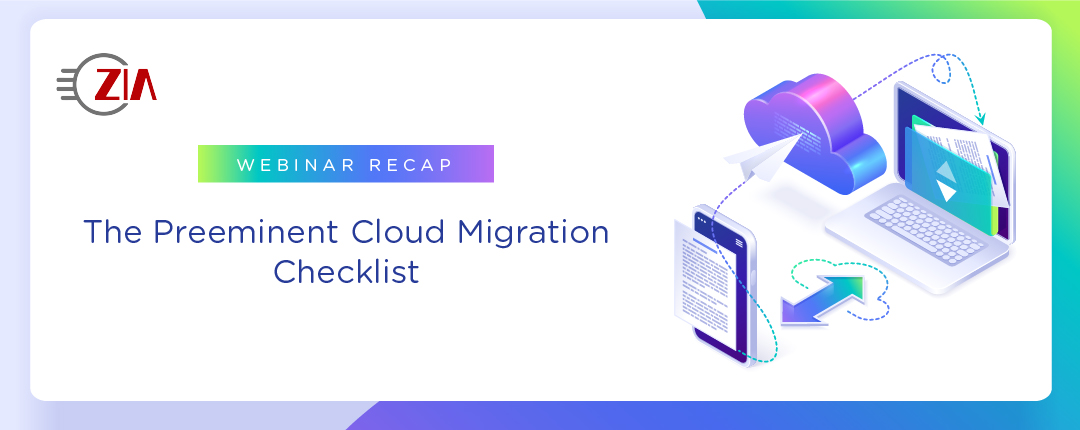Cloud migration doesn’t have to be scary and the journey can be managed in specific increments. You simply need a solid plan and a tried-and-true checklist to move valuable business data from legacy infrastructures to the Cloud. Doing this allows you to be more ‘tech nimble’ and responsive to business owners. This blog is a webinar summary designed to help you approach your next cloud migration project with a smart strategy for teamwork, streamlining processes, and adhering to compliance standards.
Current Trends in Content Services
Companies face issues like adjusting to market volatility, dealing with fragmented IT infrastructures, and implementing a proactive governance solution. Zia Consulting addresses these issues in a way that is agile, iterative, and rich with hyperautomation solutions like business process management (BPM), robotic process automation (RPA), and artificial intelligence (AI). The ultimate objective is to have a data-driven experience that is fully integrated.
Key Cloud Migration Focus Areas
Cloud migration helps to reduce risks, avoid surprises, set realistic expectations, create alignment among IT staff, and save money. The IT aspect of Cloud Migration involves planning, prioritizing systems to migrate or consolidate, and doing a cloud assessment. It starts with understanding your data. During the planning phase, it is important to identify the document infrastructure and classify content as either an application or platform that is redundant, dead, legacy, or modern. The next step is to identify the document repositories, content centric processes, and security paradigms. This helps manage the impacts to customers and internal users. The next step is the cloud assessment. This phase involves testing how the content looks in the cloud, estimating cost, and determining a plan for ongoing maintenance and administration.
From an architectural standpoint, content can be captured and managed regardless of its age. Content is often migrated from mainframes or open systems to the cloud by moving it to new storage platforms. Then customers can use data driven applications that allow them to take full advantage of features and functions available in the new cloud environment and storage platform. Some customers start with advanced case management (ACM), while others need a more complex suite of cloud services like orchestrations, containerization, and dynamic load balancing.
On the business side, it is important to determine cost, as well as alignment with the modernization team, business owners, and end users. Several factors go into controlling cost, but at the most basic level it is determined by the amount of content, how it is stored, and dependencies with systems, data, documents, and applications. Federation can be leveraged across all repositories like Sharepoint, or integrated with systems like Salesforce, Workday or SAP. This strategy offers users a single interface to access content in all applications and repositories.
Innovation and automation happen by addressing manual gaps and redundant tasks. Replace these with new platform capabilities in cloud, hybrid-cloud, and multi-cloud scenarios. The goal is to maintain alignment with business objectives, find business value, avoid disruptions, and minimize confusion during and after the migration.
Migrating to the cloud allows users to take full advantage of governance features. Customers wanting application consolidation or modernization often go through a process of discovery, classification, network breaches, over retention, redaction, and access management. New platform features allow a person to discover what is in current repositories (e.g., Rocket, Sharepoint, OneDrive, etc.) and develop a detailed lifecycle management plan that applies classification rules to file systems that capture desired information. Here the goal is to minimize governance exposure, while centralizing key documents and data assets. Governance should be fully automated with the ability to manually intervene or it will not work.
Cloud Migration Checklist
Doing a robust, flexible, data-driven, cloud-based or hybrid content modernization solution is easier with Zia Consulting’s tried-and-true checklist. Zia is a systems integrator that takes a ready, aim, fire approach to providing enterprise content management (ECM) planning, design, implementation, and support services. Often customers are ready to go to the cloud and begin a migration process without aiming first. Zia’s in-depth experience with intelligent document capture (IDC), automated workflow, personal information (PI), and governance helps customers think through the necessary steps between being ready and firin .
Step 1: Take Advantage of Assessment Tools
The assessment involves defining the goals and objectives, determining cloud readiness, and defining the budget. Whether it is a single application/content platform, or an entire lift and shift of the organization, there are a number of tools to determine what is best for your organization.
There are two components to determining cloud readiness. One is deciding if the cultural fit and commitment level of the organization matches the project. A migration is easier when executives, staff members, IT, stakeholders, and end-users are in alignment. Companies also need to assess if they have the expertise, resources, and capacity to do the migration and managed services post-migration. If not, additional partners may be needed to support any gaps.
The second component to cloud readiness is to build a priority checklist. With every cloud migration, Zia encourages companies to automate their governance and compliance. This is especially important since many jurisdictions have different laws, or levels of governance and compliance, as it relates to PI. Leaving compliance and governance to a manual process often leads to failed governance at some point.
Step 2: Plan Your Migration to the Cloud
Create a plan, evaluate it against the projected budget, and make adjustments as needed. Then define the strategy for each application. Brad Steinmeyer from Zia Consulting suggested that you, “Look at it like ‘application Jenga’. Identify which applications can be moved and when so that you don’t topple the application capabilities.” Then you have to decide how to move them, which gets into the R’s – rehost, redo, or rewrap. Make decisions about new technologies or leaving certain content from older technologies in place.
Next, design the cloud infrastructure and develop a management plan. Ensure the network infrastructure allows end-users to access information. Consider what API integration or reconfiguration requirements are needed. Build the migration plan and create a schedule for moving applications and associated data. Identify needed supports, develop a plan for testing and validation, and build a rollback plan in case something goes wrong. Use tools to address data that is redundant, obsolete, or trivial (ROT). Don’t make the mistake of transferring data sprawl into the new application.
Executing Your Plan
Migration, modernization, and digital transformation efforts should be done in small sprints with quick wins. This helps build morale and a culture that enrolls everyone in the project. Creating large, two year plans, can fall apart along the way. Organizations can experience changing needs, new technologies, or migration fatigue. It can be helpful to study the lessons learned after each sprint. Review and test security along the way. Don’t quit when the project is finished. Go back to the organization and look for ways to leverage the expertise and experience from that project to other transformation and modernization initiatives.
Zia is agile and will help you develop a plan for your migration projects. Click here for the full cloud migration checklist. Check out our website to learn more about how Zia approaches effective migration of your business-critical documents to a modern ECM platform, or the cloud, without interrupting daily functions. Feel free to reach out to us today for a free consultation with one of our experts.

ABOUT THE AUTHOR
Shelly Mahon, Marketing Communications Manager
Shelly has over 25 years of experience as a content creator, writer, editor, professor, speaker, and group facilitator. She has worked in academia, government, for-profit, independent contracting, and non-profit, including C-Level positions. As the Marketing Communications Manager for Zia Consulting, Shelly serves as the main point of contact for social media, research efforts, and all written communication. She works in conjunction with a talented team that creates and designs marketing campaigns, orchestrates the generation of blogs and white papers, and records webinars in the area of information technology services. In her free time, she cycles, mountain bikes, runs, and skis as much as possible.

ABOUT THE AUTHOR
Brad Steinmeyer, Enterprise Sales Director
Brad has 25+ years of experience in technology sales, consulting, and leadership. Based in Boulder, his expertise in cloud and managed services rounds out the Zia team as demand for these services continues to grow. Brad’s focus centers on our customers’ digital transformation initiatives, offering insight into how our solutions integrate into their optimal business outcome. In Brad’s time away from the office, he backpacks and adventures with his two Huskies who love playing in the snow.

